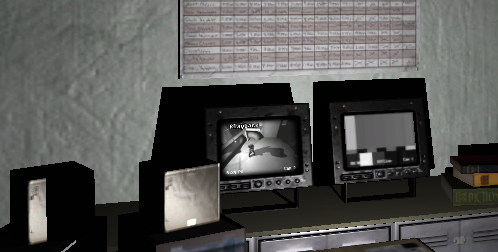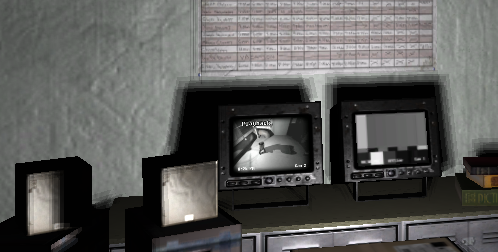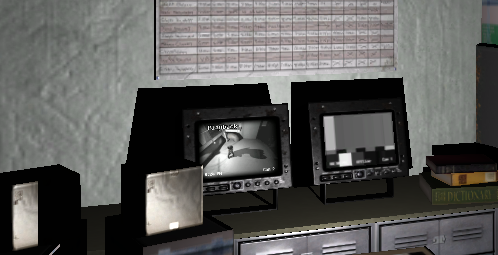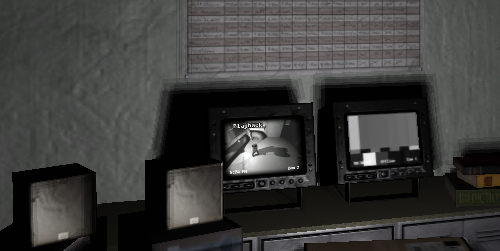F.E.A.R. GPU Performance Tests: Setting a New Standard
by Josh Venning on October 20, 2005 9:00 AM EST- Posted in
- GPUs
The Failure of Soft Shadows and Parallax Mapping
Soft Shadows
We've seen how soft shadows can be used effectively in games like The Chronicles of Riddick, and Monolith has decided to add this as an option in FEAR. Used correctly, soft shadows greatly enhance lighting in a game by giving shadows cast by objects different levels of darkness making them more realistic. This process can take up a lot of processing power however, and that's no exception for FEAR.
Basically, soft shadows are an effect that show how shadows tend to fade at the edges or cast overlapping lines on walls or objects depending on different factors such as light angle and distance. If you've ever made a shadow-puppet, you can see this clearly, as multiple outlines of your hand shadow overlap on the wall with varying degrees of darkness (depending on the light source). And if you were to move your hand closer or farther away from the light, you can see how the soft shadows change dynamically.
The idea is to capture this effect in a game environment, but as any programmer would know, translating this to a game engine can be a very complex undertaking. Not only that, but as we mentioned before, calculating multiple shadows in real time can quickly become a major leech of processing power. With FEAR, we've seen how big of a performance hit that we had when we enabled soft shadows, but you may wonder, "does the effect at least look good?"
The short answer is "no". The way that FEAR incorporates soft shadows ends up looking unrealistic; more stratified and strange than soft. It simply looks as though the game draws multiple shadows at the edges of objects and offsets them up, down, left and right very slightly at different degrees of darkness regardless of the light source. This wouldn't be so bad if the multiple shadows were not readily noticeable as such. It also would have been nice if the "blur factor" were more dynamic; in other words, moving the shadows closer together or farther apart given where the object (say an enemy soldier) is in relation to the light sources and shadowed surfaces.
This is difficult to understand until you see it happening in the game, but you can get a better idea of it by looking at a few pictures. We took some screen shots of a scene with and without soft shadows enabled with both NVIDIA and ATI cards. Please ignore the slight lighting and position differences of these screens.
Parallax Mapping
While the detailed textures, excellent lighting, well done static and dynamic shadows (in spite of the soft shadow issue), large intricate particle systems, and various beautiful effects of FEAR come together to form an immersive and fluid graphical experience, there are a few caveats. To their credit, Monolith was very aggressive with the features that they included and are on the leading edge of technology. The use of a deep parallax mapping algorithm to represent damage is a very cool idea, but the implementation used in FEAR doesn't include key features such as self-occlusion and self-shadowing. When passing a wall with a chunk blown out, the hole will swim around, flatten out, and eventually look like unidentifiable goo stuck to the wall as the angle gets very steep.
The parallax mapping used looks great from angles where the entire interior of a hole can be seen. The problem occurs at viewing angles where a near edge would need to block the view of part of (or the entire) interior of the indention. Rather than occluding anything, parts of the texture that should become invisible are still shown (albeit distorted). This completely destroys the illusion of depth at steep angles by making the texture kind of swim until it totally loses its three-dimensionality. There are algorithms available that can represent correctly self-occlusion in parallax mapping. While we can appreciate cheaper parallax mapping algorithms as a kind of upgraded bump mapping, dramatic surface deformation should either be done more correctly or not at all in cases where the viewer can move to angles that break the effect.
But again, we would love to give credit where credit is due. We would rather see game developers experiment with new technology and put something out there than let the true power of our graphics cards remain dormant. Monolith was ahead of the curve with the graphics in Tron 2.0, and they haven't let us down with the quality of FEAR.
Soft Shadows
We've seen how soft shadows can be used effectively in games like The Chronicles of Riddick, and Monolith has decided to add this as an option in FEAR. Used correctly, soft shadows greatly enhance lighting in a game by giving shadows cast by objects different levels of darkness making them more realistic. This process can take up a lot of processing power however, and that's no exception for FEAR.
Basically, soft shadows are an effect that show how shadows tend to fade at the edges or cast overlapping lines on walls or objects depending on different factors such as light angle and distance. If you've ever made a shadow-puppet, you can see this clearly, as multiple outlines of your hand shadow overlap on the wall with varying degrees of darkness (depending on the light source). And if you were to move your hand closer or farther away from the light, you can see how the soft shadows change dynamically.
The idea is to capture this effect in a game environment, but as any programmer would know, translating this to a game engine can be a very complex undertaking. Not only that, but as we mentioned before, calculating multiple shadows in real time can quickly become a major leech of processing power. With FEAR, we've seen how big of a performance hit that we had when we enabled soft shadows, but you may wonder, "does the effect at least look good?"
The short answer is "no". The way that FEAR incorporates soft shadows ends up looking unrealistic; more stratified and strange than soft. It simply looks as though the game draws multiple shadows at the edges of objects and offsets them up, down, left and right very slightly at different degrees of darkness regardless of the light source. This wouldn't be so bad if the multiple shadows were not readily noticeable as such. It also would have been nice if the "blur factor" were more dynamic; in other words, moving the shadows closer together or farther apart given where the object (say an enemy soldier) is in relation to the light sources and shadowed surfaces.
This is difficult to understand until you see it happening in the game, but you can get a better idea of it by looking at a few pictures. We took some screen shots of a scene with and without soft shadows enabled with both NVIDIA and ATI cards. Please ignore the slight lighting and position differences of these screens.




Parallax Mapping
While the detailed textures, excellent lighting, well done static and dynamic shadows (in spite of the soft shadow issue), large intricate particle systems, and various beautiful effects of FEAR come together to form an immersive and fluid graphical experience, there are a few caveats. To their credit, Monolith was very aggressive with the features that they included and are on the leading edge of technology. The use of a deep parallax mapping algorithm to represent damage is a very cool idea, but the implementation used in FEAR doesn't include key features such as self-occlusion and self-shadowing. When passing a wall with a chunk blown out, the hole will swim around, flatten out, and eventually look like unidentifiable goo stuck to the wall as the angle gets very steep.
The parallax mapping used looks great from angles where the entire interior of a hole can be seen. The problem occurs at viewing angles where a near edge would need to block the view of part of (or the entire) interior of the indention. Rather than occluding anything, parts of the texture that should become invisible are still shown (albeit distorted). This completely destroys the illusion of depth at steep angles by making the texture kind of swim until it totally loses its three-dimensionality. There are algorithms available that can represent correctly self-occlusion in parallax mapping. While we can appreciate cheaper parallax mapping algorithms as a kind of upgraded bump mapping, dramatic surface deformation should either be done more correctly or not at all in cases where the viewer can move to angles that break the effect.
But again, we would love to give credit where credit is due. We would rather see game developers experiment with new technology and put something out there than let the true power of our graphics cards remain dormant. Monolith was ahead of the curve with the graphics in Tron 2.0, and they haven't let us down with the quality of FEAR.










117 Comments
View All Comments
Le Québécois - Friday, October 21, 2005 - link
And That's why they just do at least a couple of test with slower CPU to see if it affect the FPS or not...I dont say screw the FX57...I juste say..why dont you do a couple a test with a slower CPU to see if it makes a difference....Hardtarget - Friday, October 21, 2005 - link
Good article but I really realy hoped you would of compared a 9800Pro. It's a very very popular card that many of us still have and we'd love to know how it performs!Pjotr - Friday, October 21, 2005 - link
I've seen a trend in GPU reviews lately, in that fewer old cards are used. This review says "See if you need to upgrade", but how can I tell when my old card is not there and I have no relation to even the 800 GT? I would like to see more old cards. 9800 Pro is probably a card a LOT of people have, it would be great to include this card and perhaps 2-3 more from around that generation.fogeyman - Friday, October 21, 2005 - link
"why would anyone make a game with a no name legacy that has no ability to be played in full with a system that would cost 3000 dollars? "This is a huge exaggeration. I have a new, just under $2000 system with an x2 4200+, 7800gt, and 2 gb of memory. I can also play FEAR on 1280x1024 (that's the highest resolution my monitor can support) with all graphics settings turned on (except for soft shadows, I believe) with no noticeable issues. So while my system is a high-end system, zero playability on a $3000 system is a MASSIVE exaggeration.
In fact, for ~$2400 (the cost for me to upgrade my system to 7800gtx SLI), I could play the game flawlessly on 1280x1024 with all settings turned on. The SLI is probably overkill, in any case, meaning for ~$1900, you can play FEAR easily. Not to mention the graphics are OUTSTANDING at this level. The gameplay is amazing and the physics are to die for (I've spent hours mesmerizing friends during one part of the demo where you can flip an enemy head over heels with the bolt gun thing. So while FEAR is INCREDIBLY demanding, the game is incredibly amazing.
"sick of this assinine increase in resolutions. I bet the game actually sux after playing it for 2 days like most do."
Like Derek said, this game is outstanding. It's not absolutely and utterly captivating like HL2, nor is it as practical as HL2, but the game is still awesome.
"with a no name legacy"
Companies have to make a name for themselves. Great gameplay is one way, groundbreaking graphics is another, and a combination of the two is even better. FEAR has both. Additionally, Monolith has come out with great games in the past that have been rejected by the market. If you want me to come up with some examples, I'll dig up some games and give you some.
Granted, these games aren't "uberly leet" like HL2, but you can't expect every game to get ratings as high as 95+.
Basically, don't post irrational posts that exaggerate the truth. This isn't the time to slander FEAR or monolith or anything else, really. And there's no reason to create "flame wars." Post calm. Post decently. And post rationally...and I probably have some irrational points in here too, so just point them out and I'll attempt to fix it. If I can't, then you win. Happy?
FPSnut - Saturday, October 22, 2005 - link
Fogeyman,How did you get the game to play at 1280x1024? I only see an option for 1280x960...
Thanks in advance!
fogeyman - Friday, October 21, 2005 - link
Forgot to add this:I also agree with what seems to be a popular opinion that this review is lacking info. It doesn't show us the incredibly out-of-reach SLI setups, making the review more user-tailored and less FEAR-bragging tailored, but few (if any) AGP cards are shown. This makes the review tailed towards the "high" gaming community instead of the mainstream community.
I would be happier with more lower end cards shown, more varied graphics settings chosen, and far fewer top-of-the-line cards. For example, instead of the 7800gtx and the 7800gt, I would have been okay with just the gtx or just the gt. While this leaves out a very nice card, for purposes of practically it might be better to let users extrapolate the fps for the other card, and instead show some mid-range cards as well.
If time doesn't allow for this, then perhaps make it more clear that you intend to release another, more comprehensive, review soon so we can get an overview in the first, rush-review and a more detailed review after a few weeks.
On a side note, I heard rumors that the release of FEAR is multi-threaded. Is this true?
Le Québécois - Friday, October 21, 2005 - link
Well...testing it on a X2 VS a FX55 would make an interesting benchmark but all the reviews I have read so far use FX55-57 processor...And Btw...when CPU speed is taken in consideration ...the FPS in FEAR doesn't change much.. a AMD 64 3200 and a FX57 both run the game at almost the same speed ( give or take 1-2 fps ).ElJefe - Friday, October 21, 2005 - link
the game can fear "this" *grabs a lower organ*why would anyone make a game with a no name legacy that has no ability to be played in full with a system that would cost 3000 dollars?
for that id go to europe and rent someone named fear to hang out with or something.
sick of this assinine increase in resolutions. I bet the game actually sux after playing it for 2 days like most do.
Now a game like half-life2, that was a game you would consider getting a new system for, or for final fantasy, or for doomIII (even though it bugged out too many people and died fast).
they should make a new game that requires two overclocked liquid cooled only 7800GTXs in sli mode that gets 4 frames at 640 resolution. that would really help out the industry! yeah!
9nails - Saturday, October 22, 2005 - link
FEAR is a top 10 game. It will become a benchmark for games follow. Imagine a developer that took some of their favorite levels from current games and worked those ideas into a believable environment. Then took a horror movie and tied it to a game and have it play on your mind more than in your eyes. Then toss in some enemy AI that does a lot more than predictably pop out from the same side of a crate; an AI that can actually flank, hide, work together, and corner the player. Then they actually play tested this game with real gamers and adjusted the difficulty to make sure there wasn't something stupid like a flood of Combine attacking you in prison when you had no health and little defense. Now wrap it up this game in cutting edge visuals.I have the FEAR Director's Edition DVD, and highly recommend it. And I'm only playing on a P4 2.8 with 1 Gig and a 6800GT. Everything is maxed at 1024, and it looks stunning.
DerekWilson - Friday, October 21, 2005 - link
the game is actually fun and has enemies that are interesting. Half life 2 was bad enough with its enemy AI, but doom 3 had every enemy of a certain type doing exactly the same thing after its initial jump out and scare you routine. it was really boring killing enemies like that.FEAR actually has enemies that can do different and interesting things depending on the current landscape, and it seems they work together better in this game than others.
I'd say that as a single person shooter, FEAR has better playability than many other games out there.
And, again, lower settings run at higher frame rates.